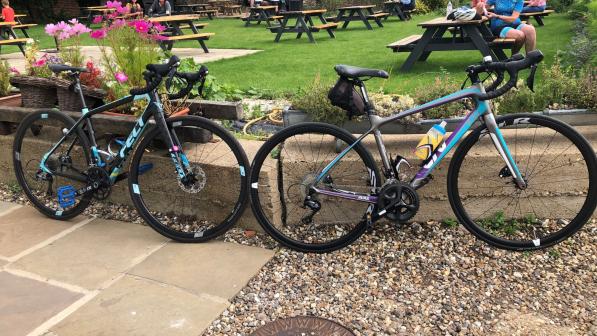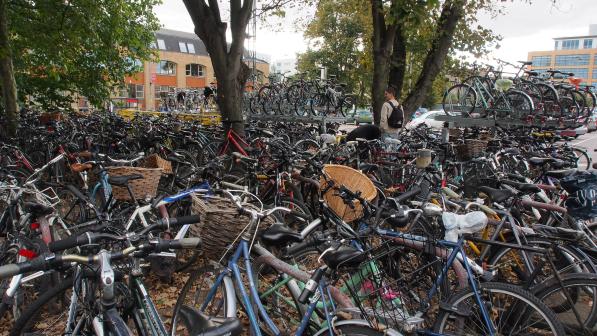Getting your child ready to ride to school, college or uni

Cycling to school is a fun, eco-friendly and healthy way for children and students to travel and stay active. Whether your child is just starting school, heading to college or going off to university, it’s important to prepare them for the ride ahead.
This article offers practical tips to ensure safety, comfort and confidence when riding, broken down by age group: young children and older students.
Tips for all ages
Clothing for visibility
Wearing bright clothing is crucial for being visible to other road users. This doesn’t have to mean high-vis gear, but brighter colours which make it easier for motorists to spot. Let your child choose their cycling clothing so they feel comfortable and confident.
This is especially important if you want your child to wear a helmet; if they choose it, they’re more likely to wear it. Avoid full head helmets as these are not designed for riding in traffic or on cycle paths/shared use paths – they reduce peripheral vision and hearing.
A waterproof jacket and shoes with a non-slip sole are also sensible purchases. For winter months a front and rear bike light are essentials – it’s useful to get USB chargeable ones so you're not having to mess with batteries.
Students need to carry books and other equipment such as sports kit, so a waterproof rucksack or panniers are useful – look for ones with a reflective trim for additional visibility.
Bike-handling skills
Every cyclist needs to control their bike with confidence, and understanding how to use gears is a key part of this. Keep gears simple for children.
If you have a thumb and finger shifter on your right hand explain “the thumb makes it easier, finger makes it harder” – that way they aren’t getting bogged down with low versus high or remembering which way round the numbers are.
If pedalling feels too easy, use your finger to change gear. If it’s too hard, use your thumb. This can easily be adapted to explain grip shifters as well.
Other essential skills include riding in a straight line, looking over the shoulder, and riding one-handed for signalling. These basic manoeuvres are important for navigating roads safely.
Making eye contact
Encourage your child to make eye contact with drivers, especially when crossing side roads or intersections. Looking into the eyes of the driver of the vehicle to check if they’ve seen you is important. Explain that if you don’t think the driver has made eye contact with you then be prepared to brake.
Bike maintenance
Regular bike checks are essential. Ensure the bike is the right size – children grow quickly, and an ill-fitting bike can be uncomfortable or unsafe. Check if the saddle height is appropriate and whether the bike still suits their needs.
Developing road sense
Cycling safely on roads requires strong road sense. For younger children, this can be learned through formal training like Bikeability sessions, but riding with more experienced cyclists – whether a parent or friend – remains one of the best ways to gain practical experience.
As students grow older and more independent, continued guidance and practice on busier routes are invaluable for building both confidence and competence.

For young children: first rides to school
Developing basic bike skills
Young children need to master basic bike skills such as balance, steering, and braking. Practice in safe, traffic-free areas to help them grow in confidence. Make learning fun by incorporating games that develop essential skills like riding in a straight line or signalling one handed.
Accompanying them
If you’re cycling with your child, ride two-abreast with you on the outside (closer to traffic). This gives your child a buffer from vehicles and follows the guidance in the Highway Code. It will make you and them feel more confident on the road and reduce the risk of an inappropriate overtake.
If you want to see them riding more independently then riding behind them allows you to see how they are riding. Are they making good decisions? Making correct observations? Selecting the correct road position?
All these things you can see from behind, which also allows you to easily take control if needed as your voice will travel forward towards them rather than ahead of you and maybe get lost in the wind.
Making cycling fun
Encouraging a love for cycling goes beyond the daily commute to school. Take your child on leisurely bike rides, where they can explore and have fun. This not only builds their enthusiasm for cycling but also helps them improve their skills in a relaxed environment.
For older students and college/university riders
Navigating busier roads
Older students and university riders often need to tackle more complex road conditions. They should be confident in handling their bike, especially when it comes to signalling, checking over their shoulder and riding in a straight line. Remind them to make eye contact with drivers at junctions and to be cautious if the driver doesn’t see them.
Bike handling skills, such as understanding gears and controlling the bike in traffic, become even more important as students face busier roads. Encourage them to continue developing these skills by practicing with experienced riders or attending advanced training sessions.
Bike security
As students start leaving their bikes in public or semi-public spaces like schools, colleges or universities, bike security becomes critical. A sturdy lock is essential, and it’s important to know how to secure both the frame and wheels properly.
Avoid using bikes with quick-release wheels or seats in areas where theft is common, and always remove lights, panniers and other accessories when locking up the bike.
If heading off to university, check the bike storage arrangements in advance. Some halls of residence require pre-booking for bike storage, and bikes are typically not allowed in bedrooms.
Additionally, encourage your child to review their bike insurance, paying close attention to how and where the bike must be stored to ensure any claims will be honoured if the bike is stolen.
Advanced road sense
By this stage, students should have a good grasp of road sense, but there’s always room for improvement. Encourage them to ride with more experienced cyclists to observe and learn. Practicing on different types of roads, during varied traffic conditions, helps build confidence and sharpens judgment.
The joys of cycling
Cycling to school, college or university is an enjoyable and beneficial way for young people to stay active, develop independence, and navigate the world. By ensuring your child is equipped with the right clothing, bike handling skills and road sense, you can help them ride safely and confidently.
Remember, cycling should also be fun – so take every opportunity to explore the joy of riding beyond just the school run!


